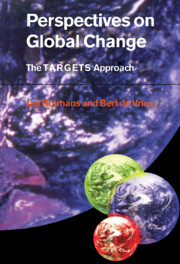Book contents
- Frontmatter
- Contents
- Foreword
- Preface
- 1 Global change and sustainable development
- Part One The TARGETS model
- Part Two Exploring images of the future
- 11 Towards integrated assessment of global change
- 12 Population and health in perspective
- 13 Energy systems in transition
- 14 Water in crisis?
- 15 Food for the future
- 16 Human disturbance of the global biogeochemical cycles
- 17 The larger picture: utopian futures
- 18 Uncertainty and risk: dystopian futures
- 19 Global change: fresh insights, no simple answers
- References
- Acronyms, units and chemical symbols
- Index
16 - Human disturbance of the global biogeochemical cycles
from Part Two - Exploring images of the future
Published online by Cambridge University Press: 06 July 2010
- Frontmatter
- Contents
- Foreword
- Preface
- 1 Global change and sustainable development
- Part One The TARGETS model
- Part Two Exploring images of the future
- 11 Towards integrated assessment of global change
- 12 Population and health in perspective
- 13 Energy systems in transition
- 14 Water in crisis?
- 15 Food for the future
- 16 Human disturbance of the global biogeochemical cycles
- 17 The larger picture: utopian futures
- 18 Uncertainty and risk: dystopian futures
- 19 Global change: fresh insights, no simple answers
- References
- Acronyms, units and chemical symbols
- Index
Summary
The key question underlying the controversies addressed in this chapter is to what extent the global biogeochemical cycles and the climate system are being disturbed by anthropogenic processes. The CYCLES submodel is used to explore the influence of various model routes on future projections of global environmental change. These routes are characterised by specific assumptions about the key processes within the global carbon (C) and nitrogen (N) cycle and the climate system. This creates the possibility to assess various emission scenarios, paving the way for the more integrated experiments described in Chapters 17 and 18. It is reiterated that the current state of scientific knowledge with respect to global C and N cycles and climate change is still beset with major uncertainties.
Introduction
Although scientific knowledge of global biogeochemical cycles is increasing rapidly, there are still major gaps. Subjective interpretation of these gaps results in different assessments of the rate, magnitude and impacts of human-induced changes in global cycles. The climate debate exemplifies the kind of intellectual battle that can take place, given uncertainties about the global biogeochemical cycles of the basic elements carbon (C), nitrogen (N), phosphorus (P) and sulphur (S), and the climate system. In general, the controversies within the scientific community on global biogeochemical cycles focus on the relationships among the physical, biological and chemical processes comprising the complex dynamics of the global biogeochemical cycling as well as the role of the various feedbacks.
- Type
- Chapter
- Information
- Perspectives on Global ChangeThe TARGETS Approach, pp. 345 - 370Publisher: Cambridge University PressPrint publication year: 1997

